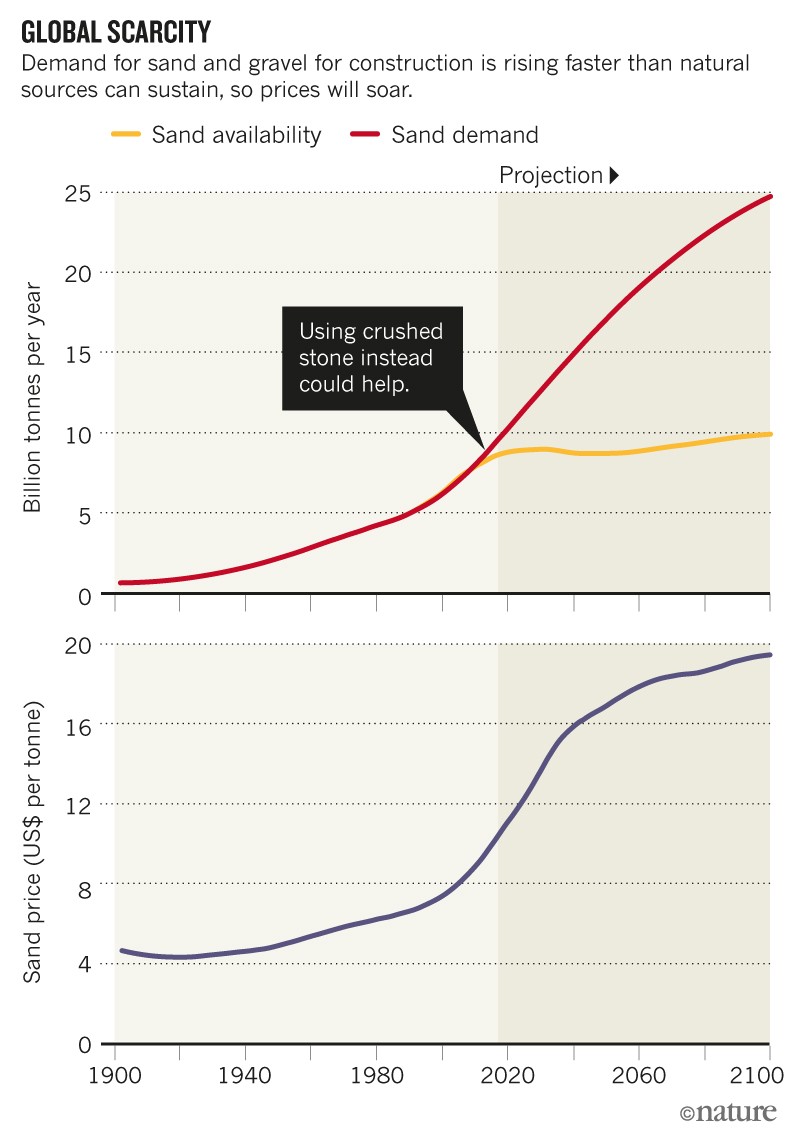From the Journal Nature, July 2, 2019:
"Desert sand grains are too smooth to be useful, and most of
the angular sand
that is suitable for industry comes from rivers (less
than 1% of the world’s land)"
Sand and gravel are being extracted faster than they can be replaced. Monitor and manage this resource globally, urge Mette Bendixen and colleagues.
What links the building you live in, the glass you drink from and the computer you work on? Sand. It is a key ingredient of modern life and yet, astonishingly, no-one knows how much sand there is or how much is being mined.
Sand and gravel make up the most extracted group of materials, even exceeding fossil fuels1. Urbanization and global population growth are fuelling an explosion in demand, especially in China, India and Africa2. Roughly 32 billion to 50 billion tonnes are used globally each year, mainly for making concrete, glass and electronics3. This exceeds the pace of natural renewal4 such that by mid-century, demand might outstrip supply2 (see ‘Global scarcity’). A lack of knowledge and oversight is allowing this unsustainable exploitation.

Source: Ref. 2
Desert sand grains are too smooth to be useful, and most of the angular sand that is suitable for industry comes from rivers (less than 1% of the world’s land)5. This extraction of sand and gravel has far-reaching impacts on ecology, infrastructure and the livelihoods of the 3 billion people who live along rivers3,6,7 (see ‘Shifting sands’). For example, sand mining on the Pearl River (Zhujiang) in China has lowered water tables, made it harder to extract drinking water and hastened river-bed scour, damaging bridges and embankments7.HT: Ideas, Inventions and Innovations
Most of the trade in sand is undocumented. For example, between 2006 and 2016, less than 4% of the 80 million tonnes of sediment that Singapore reported having imported from Cambodia was confirmed as exported by the latter8. Illegal sand mining is rife in around 70 countries3, and hundreds of people have reportedly been killed in battles over sand in the past decade in countries including India and Kenya, among them local citizens, police officers and government officials.
All these problems have been highlighted in reports from the wildlife charity WWF and the United Nations Environment Programme (UNEP), questioning the sustainability of sand extraction3,6. The underlying reasons are too few data and a lack of policies supporting responsible consumption and extraction....MUCH MORE
If interested see also:
"Inside the deadly world of India’s sand mining mafia"
"Commodity Traders Could Be a Key Beneficiary of Climate Change"
Greenland's sand barons as well.
Sand from Greenland’s Melting Ice Sheet Could Bring in Business
Commodities: The Next Big Thing Is Sand
"A World Built on Sand and Oil"
We too have experienced the allure of sand.
Usually at the beach but on the blog as well....